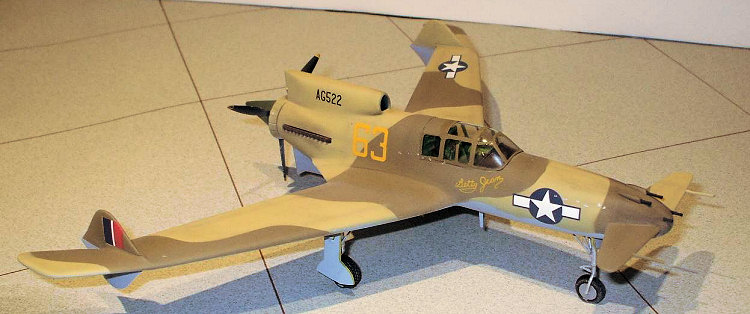
Czech Model 1/48 XP-55 Ascender
| KIT #: | 4806 |
| PRICE: | $24.95 MSRP |
| DECALS: | One option |
| REVIEWER: | Dale Rannals |
| NOTES: | Limited run multimedia kit |

| HISTORY |
Stan woke up to the sound of the air raid siren wailing. “They’re coming again” he thought…did the ground crew have time to re-fuel and re-arm his crate? It seemed like he just landed minutes ago. A quick glance at the clock told him yes…and he’d actually gotten a two hour nap in. His mind raced as he jumped into his gear and headed toward the door. “How could they mount another attack so quickly? Hmmmmm….maybe we didn’t get as many as we claimed earlier.”
As he opened the door, a tent flap in reality, the sand assaulted him. “Argh….the sand. The sand gets everywhere.” He looked quickly and found his mount, sprinting towards it. The crew was just closing up the ammunition hatches. “Perfect timing.” he thought. His crate, as the Brits would call it, was a strange looking beast. “Bloody Arse-ender” was another of their favorite monikers. For the P-55 Ascender it was certainly a fitting name. Tail in front, motor in back, it looked like the engineers got things all mixed up. Always looked to be flying the wrong way.
Taxiing out, Stan started running up the engine, the unmistakable sound of the Sabre shrieking while he waited for his turn. The Ascender was a non-started originally. The Allison just didn’t make the power the airframe needed. ‘Twas the British that turned it into a world-beater when they shoe-horned a Napier Sabre engine into it. Well, it was a world-beater if you didn’t count the jets.
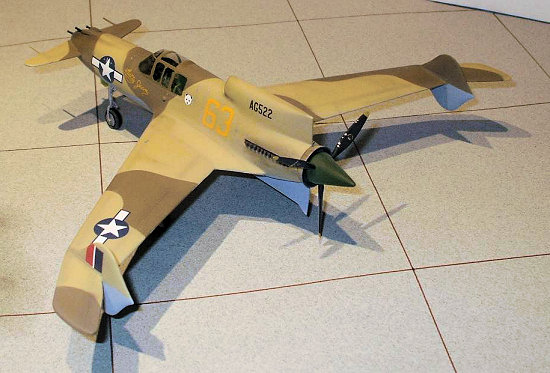 The
jets…..the very reason Stan was sitting here in Africa, going off to repel
another raid from the Luftwaffe. A raid from the very country whose days were
so numbered back in ’43. Things where going well for the allies…if you can
consider any war “well”. Germany was on the brink of defeat. Then the jets
came. The jet fighters the allied intelligence said where a couple years away
started destroying bomber formations almost at will. We had no counter, no
immediate means to fight this threat. Pulling back was the only option. Hold
‘em off till we can put something comparable in the sky. The British bought
Ascenders by the hundreds; with the Sabres installed they could hold their own,
but it was still a losing battle. Once they got their Vampire jets produced in
sufficient numbers, they gave the Ascenders back to the Army Air Corps. Kind of
a reverse lend-lease if you will. So, as it stood, the Vampires and Shooting
Stars got to duke it out with the Me-262’s and Ta-183’s over Europe where all
the focus was. With the Axis Powers’ big push back into Africa, the “second
starters”, the Ascenders and Superbolts, went up to duel with the Me-309’s in a
war that nobody seemed to notice.
The
jets…..the very reason Stan was sitting here in Africa, going off to repel
another raid from the Luftwaffe. A raid from the very country whose days were
so numbered back in ’43. Things where going well for the allies…if you can
consider any war “well”. Germany was on the brink of defeat. Then the jets
came. The jet fighters the allied intelligence said where a couple years away
started destroying bomber formations almost at will. We had no counter, no
immediate means to fight this threat. Pulling back was the only option. Hold
‘em off till we can put something comparable in the sky. The British bought
Ascenders by the hundreds; with the Sabres installed they could hold their own,
but it was still a losing battle. Once they got their Vampire jets produced in
sufficient numbers, they gave the Ascenders back to the Army Air Corps. Kind of
a reverse lend-lease if you will. So, as it stood, the Vampires and Shooting
Stars got to duke it out with the Me-262’s and Ta-183’s over Europe where all
the focus was. With the Axis Powers’ big push back into Africa, the “second
starters”, the Ascenders and Superbolts, went up to duel with the Me-309’s in a
war that nobody seemed to notice.
Startled back to the present by the Ascender to his right pulling forward, Stan pushed the throttle forward and was pushed back in his seat as the big plane rushed ahead. Once airborne he spotted his wingman, formed up and got the call from ground control with his vector to the bogies. Time to climb. 2000ft….3000…5000. At 10,000ft Stan saw a now familiar sight…..the P-47J Superbolts leaped past him and roared above. Man they could climb! They took off last and were already 1000ft above him. Stan hoped they would find and deal with the enemy fighter escorts. That would leave Stan and his flight to deal with the bombers, a job the more heavily armed Arse-enders could do well with their 4 20mm cannon and 2 30cal machine guns.
As they arrived at Angels17 Stan could see the battle ahead. The ‘Bolts were mixing it up well with the Me-309’s. Everywhere in the sky the pretty twinkling of cannon and machine gun….pretty only if they weren’t twinkling in your direction! A pair of 309s with their oh-so-tiny wings flashed past with a Superbolt jockey on their tail just as Stan spotted the bombers and a flight of 309’s breaking their way. Must be new, Stan thought, as he watched the enemy planes turn in the wrong direction. Many stories were told of enemy pilots mistaking the flight direction of Ascenders, with their strange layout, and “breaking into them” the wrong way. A small turn of their own would put them on the enemy fighter’s tails, but Stan had bigger targets in mind. The ‘Bolt pilots could deal with the 309’s.
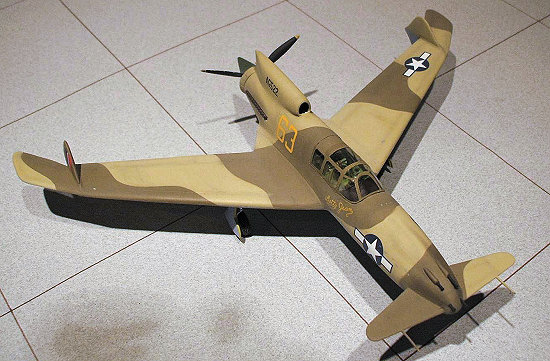 There
they were, the bombers. Big ones this time, Heinkel Greifs, He-177’s. Bigger
targets for sure but they also packed a powerful sting. Turning his flight into
the oncoming formation, Stan set himself up for a head-on pass. The enemy
gunners started firing about the same time as Stan pulled the trigger. He knew
it was just psychological, but they all seemed to be firing at him alone. He
saw hits on the bombers fuselage and left engine, which immediately started to
trail smoke. In a flash he was past it, continuing in a shallow dive to
maintain his airspeed. He was just starting a turn back around when his plane
was jolted and jarred; the unmistakable percussion of cannon hits. He banked
hard as the enemy fighter overshot him. He brought the nose back around and
fired, but it was an empty gesture. His crate was losing power fast. The Sabre
just wasn’t sounding all that smooth anymore. He dropped the nose back down,
saw the heavy black smoke he was trailing and figured he best make back for
base. It wasn’t that far……really. But as the minutes passed and the engine
making noises he’d wished he never heard, he knew he’d have to leave the hard
way. Better to take to the silk than try to deadstick an Ascender. He fired
the explosive bolts and watched the propeller whirl away into the distance.
Open the canopy, unbuckle the harness and then go. A strange almost weightless
feeling as he watched the plane fall away from him. As the chute opened he
looked up and saw his wingman circling. As he looked down he thought
”Great……sand. It gets everywhere…”
There
they were, the bombers. Big ones this time, Heinkel Greifs, He-177’s. Bigger
targets for sure but they also packed a powerful sting. Turning his flight into
the oncoming formation, Stan set himself up for a head-on pass. The enemy
gunners started firing about the same time as Stan pulled the trigger. He knew
it was just psychological, but they all seemed to be firing at him alone. He
saw hits on the bombers fuselage and left engine, which immediately started to
trail smoke. In a flash he was past it, continuing in a shallow dive to
maintain his airspeed. He was just starting a turn back around when his plane
was jolted and jarred; the unmistakable percussion of cannon hits. He banked
hard as the enemy fighter overshot him. He brought the nose back around and
fired, but it was an empty gesture. His crate was losing power fast. The Sabre
just wasn’t sounding all that smooth anymore. He dropped the nose back down,
saw the heavy black smoke he was trailing and figured he best make back for
base. It wasn’t that far……really. But as the minutes passed and the engine
making noises he’d wished he never heard, he knew he’d have to leave the hard
way. Better to take to the silk than try to deadstick an Ascender. He fired
the explosive bolts and watched the propeller whirl away into the distance.
Open the canopy, unbuckle the harness and then go. A strange almost weightless
feeling as he watched the plane fall away from him. As the chute opened he
looked up and saw his wingman circling. As he looked down he thought
”Great……sand. It gets everywhere…”
The reality:
The XP-55 Ascender was one of the unconventional designs put forth for the Army Air Corps during World War Two. The design was actually quite “right”, but was pretty much killed by the failure of the US Hyper Engine programs. These engines were all interesting designs, but none resulted in production. So the Ascender was an airframe in search of an engine. Curtiss fell back to the Allison, which really wasn’t quite powerful enough to get the desired performance. It could do no better than the conventional designs already being mass produced, and that’s pretty much where the story ended.
| THE KIT |
http://modelingmadness.com/reviews/allies/us/cleaverxp55preview.htm
| CONSTRUCTION |
Construction started by grabbing the trusty razor saw and attacking the resin
bits, removing the parts from the pour blocks. Dry fitting the resin pieces
showed the cockpit parts fitting well, but the wheel well inserts are, of
course, way too thick and will require some serious thinning to fit in the
wings. The cockpit itself is really one piece of resin, very nicely done, so
there wasn’t much to assemble there. Instrument panel and control stick and
that’s about it. After painting everything a suitable shade of green (I used
Model Master British interior green) the sidewalls were attached to the fuselage
and then the cockpit glued in place. Sounds simple aye? Actually I glued the
cockpit in place, realized it was in crooked, tried to remove it, ended up
breaking it, fixed it, and put it back in place. Nothing’s ever simple. The
resin front wheel well was installed and at the same time I epoxy’d an ample
amount of weight in front to keep her from sitting on her tail.
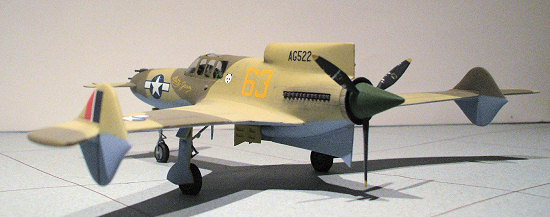
With careful alignment the fuselage halves were glued together. They fit very well, with only the seam lines to clean up. I installed the front canards and nose cone…..in retrospect I should have waited to do this because from this point on I was always fearful of the pitot tubes, if that’s what they are, breaking off and being sacrificed to the carpet monster (it had already consumed the gun sight). Amazingly, both pitots stayed in place for the rest of the build…..even withstanding the not-so-gentle attention of my youngest son!
The
wings were next, and that meant sanding down those resin wheel wells. I sanded
the back side till they were thin enough to see light thru them, then had to
sand some more on the front to get them thin enough to fit in the wings. Once
done they were superglued into the wing bottoms. The wings then went together
with no problems. Both fins were too tight, so I removed a bit of plastic
from both to get just a snug fit. I attached the wings to the fuselage
next. Fit was okay but I needed some filler on both
 sides to make it passable.
The oil cooler insert needed sanded down to fit correctly but when done the oil
cooler assembly fit very nicely to the belly of the beast.
sides to make it passable.
The oil cooler insert needed sanded down to fit correctly but when done the oil
cooler assembly fit very nicely to the belly of the beast.
I turned my attention to the propeller assembly next. It is a separate blade affair but in this case is not too hard to assemble. Each blade fits into slots in the hub so alignment isn’t much of a problem. I checked with my “alignment jig” and all looked good (or at least good enough!).
I cut out the vacuformed canopy and masked it to be ready for painting. I was hoping to put a Malcom hood it but the fuselage is much wider than the canopies I had in the spares bin. Oh well, it would have looked cool. It made me realize that this aircraft is quite large; its size is deceiving.
| COLORS & MARKINGS |
On to the paint shed. My whole motivation for this build was the above scenario…..an ex-British Ascender in desert camouflage. Two points make this an easy paintjob. 1) you can use “RAF equivalent colors” which seemed to vary quite a bit and anyway 2) it is totally fictional, so nobody can contest it! My colors of choice (all Testors Model Master series) are lightened azure blue for the underside with RAF middlestone and US field drab on top. I post shaded the panel lines with darkened mixtures; went a bit darker this time figuring in the harsh conditions it would have been under. I think it turned out well after going back and forth with colors covering up my goofs.
| FINAL CONSTRUCTION |
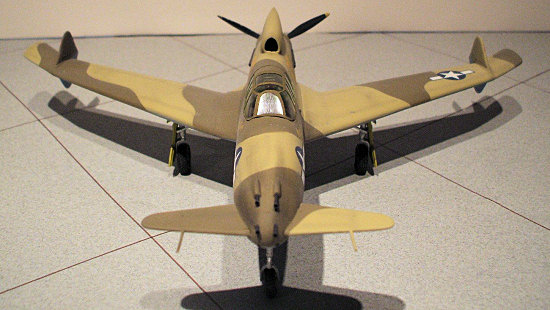 At this
point I attached the landing gear after painting the wheel wells and door
interiors with yellow zinc chromate (very much lightened). I also figured that
with the size of the nose there would be room for 4 cannon and two machine guns
so I added some resin barrels I had in the parts bin and drilled out two machine
gun ports. (The armament actually installed consisted of four .50cal machine
guns, which I consider pretty light for an aircraft this size). Lastly I
attached the resin wheels, the antenna mast, the propeller, and the canopy. For
the life of me I couldn’t get the canopy positioned quiet right. It is close so
it will have to do. This isn’t a problem of the kit, more of my abilities to
get it right.
At this
point I attached the landing gear after painting the wheel wells and door
interiors with yellow zinc chromate (very much lightened). I also figured that
with the size of the nose there would be room for 4 cannon and two machine guns
so I added some resin barrels I had in the parts bin and drilled out two machine
gun ports. (The armament actually installed consisted of four .50cal machine
guns, which I consider pretty light for an aircraft this size). Lastly I
attached the resin wheels, the antenna mast, the propeller, and the canopy. For
the life of me I couldn’t get the canopy positioned quiet right. It is close so
it will have to do. This isn’t a problem of the kit, more of my abilities to
get it right.
For decals I looked thru the decal dungeon to find suitable markings. I wanted the ex-British look, so predominately British type codes, serials and fin flashes with American insignia. I think I got “the look” right. I then did a bit of weathering and exhaust staining with chalks. And finally a coat of Testors acrylic matte finish and the beast was done.
| CONCLUSIONS |
All in all an interesting and fun build. “Some modeling skill required” is the theme for these kits, but nothing really difficult presents itself. And the whole “allied-Luft ‘46” aspect leaves the painting and markings wide open.
Maybe it should read: “Some imagination skills required.”
| REFERENCES |
Allied Aircraft Piston Engines of World War Two (an excellent book!) (ISBN 1-56091-655-9)
American Aircraft of World War Two (ISBN 1-85152-706-0)
The Internet (ISBN…oh, never mind.)
March 2007
Copyright ModelingMadness.com. All rights reserved. No reproduction in part or in whole without express permission from the editor. If you would like your product reviewed fairly and quickly, pleasecontact the editor or see other details in the
Note to
Contributors.